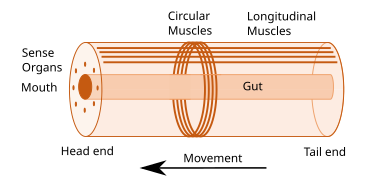Bilateria
| Bilaterians | |
|---|---|
 | |
| Bilaterian diversity | |
| Scientific classification | |
| Domain: | Eukaryota |
| Kingdom: | Animalia |
| Subkingdom: | Eumetazoa |
| Clade: | ParaHoxozoa |
| Clade: | Bilateria Hatschek, 1888 |
| Subdivisions | |
| |
| Synonyms | |
|
Triploblasts Lankester, 1873
| |
Bilateria (
Bilaterians constitute one of the five main
Body plan

Some of the earliest bilaterians were wormlike, and a bilaterian body can be conceptualized as a cylinder with a gut running between two openings, the mouth and the anus. Around the gut it has an internal body cavity, a coelom or pseudocoelom.[a] Animals with this bilaterally symmetric body plan have a head (anterior) end and a tail (posterior) end as well as a back (dorsal) and a belly (ventral); therefore they also have a left side and a right side.[4][2]
Having a front end means that this part of the body encounters stimuli, such as food, favouring
Evolution

The hypothetical
One hypothesis is that the original bilaterian was a bottom dwelling worm with a single body opening, similar to Xenoturbella.[3] Alternatively, it may have resembled the planula larvae of some cnidaria, which have some bilateral symmetry.[10] However, there is evidence that it was segmented, as the mechanism for creating segments is shared between vertebrates (deuterostomes) and arthropods (protostomes).[11]
Fossil record
The first evidence of bilateria in the fossil record comes from trace fossils in
Phylogeny
The Bilateria has traditionally been divided into two main lineages or
The traditional division of Bilateria into
A modern consensus phylogenetic tree for Bilateria is shown below, although the positions of certain clades are still controversial (dashed lines) and the tree has changed considerably since 2000.[27][25][28][29][30]
| ParaHoxozoa |
| |||||||||||||||||||||||||||||||||||||||||||||||||||||||||||||||||||||
A different hypothesis is that the Ambulacraria are sister to Xenacoelomorpha together forming the
| ParaHoxozoa |
| |||||||||||||||||||||||||||||||||||||||||||||||||||||||||||||||
See also
Notes
References
- S2CID 129376371.
- ^ ISBN 978-1-60535-375-3.
- ^ S2CID 205247296.
- ^ ISBN 978-0-19-856620-5.
- PMID 16237677. Archived from the original(PDF) on 2019-07-02. Retrieved 2018-03-07.
- PMID 9600869.
- PMID 32205432.
- S2CID 8908451.
- S2CID 80975506.
- PMID 18192186.
- ISBN 978-1-107-62139-8.
- S2CID 4395089.
- PMID 15550644.
- S2CID 205675058.
- S2CID 25112751.
- S2CID 27970523.
- .
- ^ S2CID 8531859.
- ^ S2CID 12196991.
- PMID 19602542.
- PMID 18410719.
- ^ Kimball, John W. (3 March 2010). "The Invertebrate Animals" (online biology textbook). Kimball's Biology Pages. Archived from the original on 2010-03-10. Retrieved 2006-01-09.
- abbridged by author from
ISBN 0697202844 - PMID 15249679.
- PMID 15306659.
- ^ PMID 28377584.
- ^ S2CID 205247296.
- S2CID 32169826.
- S2CID 205239797.
- ^ "Ecdysozoa". Metazoa. Palaeos (palaeos.com). Retrieved 2017-09-02.
- PMID 26605063.
- PMID 33741592.
- PMID 18192191.
- S2CID 155104811.




